Experience the high Alpine ‘High Five’ What the ‘big five’ are for those heading out on safari – elephant, lion, rhino, buffalo and leopard – are the ‘high five’ for visitors to the Grossglockner High Alpine Road - ibex, golden eagle, marmot, the Apollo butterfly and the Alpine bumble-bee. Five of many fantastic animals whose habitat is the high Alpine areas along the Grossglockner High Road, and who you get to encounter up close here.
The ‘high five’ live!
With a bit of luck, you might get to see the ‘high five’ – and many other animals of course – along the Grossglockner High Alpine Road, up close and in their natural habitats. We let you know where the best opportunities are, and what it is that makes these high Alpine animals special:
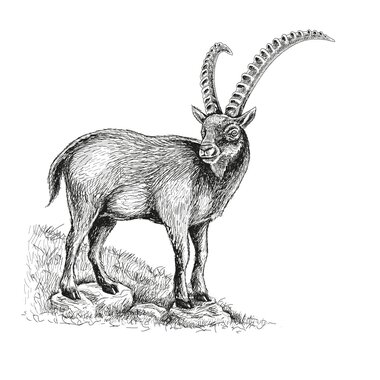
The ibex – horned King of the Alps
The ibex – also known as the ‘King of the Alps’ – lives at an altitude of between 1700 and 3500 metres and this is precisely where the Grossglockner High Alpine Road leads, up to Kaiser-Franz-Josefs-Höhe at 2369 metres. From here it is around a 10-minute walk on the panorama path to Wilhelm Swarovski Observatory. From inside this glazed gem you get to observe these majestic animals which live in a colony above the observatory in crystal-clear quality using high-precision optical equipment.
Interesting facts about the Capra ibex
Habitat
The ibex territory is at an elevation of up to 3500 metres, on steep Alpine slopes with gradients of between 35 and 45 degrees; yet even 70 degree gradients present no problem.
Height & weight
At shoulder height ibex can measure roughly one metre and they weigh up 110 kg. Females are clearly more petite; their shoulder height comes to 80 cm max, and they weigh 45 kg.
Diet
Grasses, along with herbs, small shrubs and tree shoots feature on their menu.
Lifespan
Males live to between 15 and 18, whereas females live to between 18 and 22 years old.
Grabbing the ibex by the horns
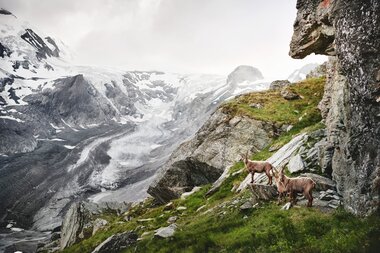
What is it that makes the ibex stand out? Their impressive horns of course! How long these become depends on gender: for females it is around 35 centimetres, while for males they can reach up to one metre! In the males, the length of their horns shows other aggressive fellow males at first glance how many years’ experience their counterpart has under their belt, and whether a showdown is worth it or not.
Exhibition
Discover the high mountain habitat interactively
In the founding community of Heiligenblut National Park, you can learn about the high mountain habitat in the "House of the Ibex" and interactively explore the world of the "King of the Alps".
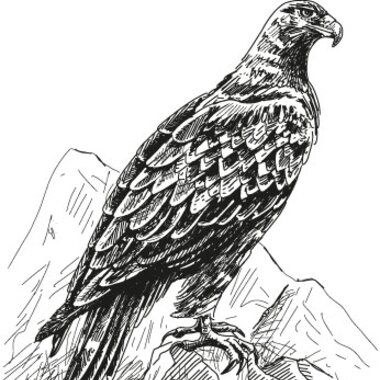
The golden eagle - majestic bird of prey
The territory of the golden eagle is located in the dizzying heights above the Hohe Tauern National Park. The population here has recovered well in recent years. The mighty bird is dark brown in colour with golden yellow feathers on its neck. This has earned it the name "Golden Eagle" in the USA. If the plumage of the golden eagle is white in colour, it is a young bird. The strongly feathered wings and broad tail enable the golden eagle to steer precisely in thermals. The "Aar", as it is poetically called, is more of a glider than a flyer.
Interesting facts about the Aquila chrysaetos
Habitat
The "territory" of a golden eagle extends over an area of 50 - 150 km². The golden eagle's eyries - i.e. nesting sites - are located at 1,100 to 2,100 metres above sea level - 95 % in rocky niches and 5 % in large trees below the hunting grounds. Why? Because it is easier to transport the prey from above down to their home.
Height & weight
The mighty bird reaches a wingspan of up to 230 cm. The high-flyers weigh between 3 and 6 kilograms.
Diet
The golden eagle's favourite food is the marmot - it makes up to 60 % of its prey. It also hunts chamois and fawns, martens, foxes, grouse, etc. In winter and spring, the bird of prey eats carrion. In this way, golden eagles make an important contribution to the ecosystem.
Lifespan
The majestic golden eagles can live up to 30 years.
Eagle eyes and powerful talons for successful hunting
The golden eagle spies its prey as it majestically glides through the air, thanks to its keen eagle-eye vision. This raptor hurtles towards its prey at a speed of over 150 km/hr, with its talons extended, compressing with an enormous force of around 70 bar! By way of comparison, two people shaking hands with one another as firmly as possible creates a pressure of around 20 bar. These birds can also maintain this pressure over a longer period of time and carry their prey to the eyrie. If the prey is heavier than their own body weight, it is broken up and the carcass transported over several days. However even the King of the Skies has to come to terms with defeat too; only one in seven hunting expedition is successful.
Raise your head and keep your eyes open!
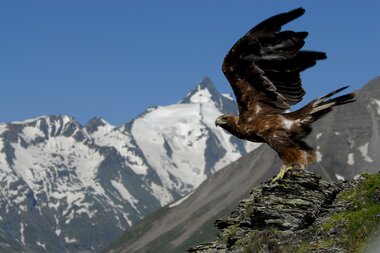
Generally speaking, golden eagles are very visible throughout the Hohe Tauern National Park. Those of you who can see the skies while out hiking have a relatively decent chance of catching sight of these majestic birds. Marmots hectically whistling is one unmistakable indicator that a bird of prey is in the vicinity.
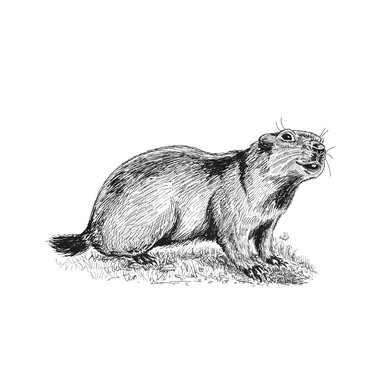
The marmot – furry, cute rodent
The animals you will encounter most frequently on the Grossglockner High Alpine Road are cute marmots. Many of these furry rodents have made a home for themselves along the road. If you are near a colony, you will hear their whistling before you see them! Marmots whistle and scream to call one another and announce any dangers. Yet every whistle means something different. If the highest ranking male whistles, this means danger and they all flee in a flash to their den. If a lower ranking marmot whistles this is ignored. Apropos ‘marmot speak’, when these cute little guys put their heads together and rub noses what they are actually doing is greeting one another. Soooo sweet!
Interesting facts about Marmota marmota
Habitat
Family groups set up their underground dens in altitude locations of between 800 and 3000 metres – that is in grassy landscapes above the treeline and in Alpine regions. One family territory can extend up to two and half hectares!
Height & weight
The body length of a fully grown marmot is between 40 and 50 cm – plus a 15 to 20 cm tail. In spring adults weigh around 3 kg, while in autumn they weigh up to 8 kg. This means they are fit – or rather, fat – for their hibernation!
Diet
Plants – fresh shoots, blossoms and buds from grasses and herbs are on the marmot’s menu. On odd occasions marmots enjoy earthworms, larvae and insects. These rodents do not drink anything, obtaining liquid from their solid food.
Lifespan
Marmots can live up to the age of 15.
Animals with depth
Whereas Ice Age mammoths and sabre-toothed tigers have long been extinct, sprightly marmots have survived the last 2.5 million years unscathed. At the end of the Ice Age, they retreated into the treeless, cooler high mountain areas. Likely because the ‘Mankei’ have few sweat glands and are not able to cool themselves down. That’s why when it is warm and sunny on the mountain they prefer to head to the cool of their den. They sleep underground at nighttime too. Six to nine months of hibernation reflect considerably in their ‘underground balance sheet’. In total the marmot spends up to 90 percent of its life underground! But their dens are comfortably appointed – with living quarters and sleeping nooks, escape tunnels and even separate toilet areas!
Marmots in the wild
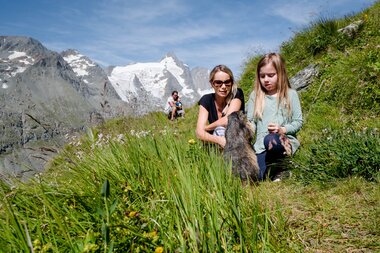
Generally speaking, golden eagles are very visible throughout the Hohe Tauern National Park. Those of you who can see the skies while out hiking have a relatively decent chance of catching sight of these majestic birds. Marmots hectically whistling is one unmistakable indicator that a bird of prey is in the vicinity.
Ferleiten wildlife and adventure park: an excursion destination for families
Would you like to experience the animals who live in the Alps up close? Then you ought to pay a visit to Ferleiten wildlife and adventure park Ferleiten! On the Salzburg side of the High Alpine Road, right at the Fusch-Ferleiten pay desk at the entrance to the wild and romantic Käfertal, is a 15 hectare wildlife park with around 200 different wild animals including ibex, wolves, marmots, chamois and lynx.
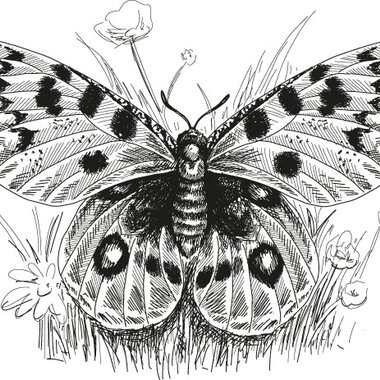
The Apollo butterfly – divine beauty
The Apollo butterfly belongs to the swallowtail family. As a typical mountain species, the Apollo adores sunny, steep rocky slopes. It is there that you can see this splendid butterfly fluttering from flower to flower. How do you recognise an Apollo butterfly? In the first instance from its red stigma, on yellow-white hindwings which are edged in black. There are one or several black spots on its forewings. And of course, the Apollo butterfly stands out due to its size alone – its wing span can reach up to eight centimetres. This little one is really quite big!
Interesting facts about the Parnassius apollo
Habitat
Open, sunny, rocky slopes and rock-strewn, dry grassy slopes intended for grazing and nutrient-poor grassland areas form the habitat for the Apollo butterfly.
Height & weight
The wingspan of these butterflies can extend to between 60 and 88 millimetres. Their size varies greatly and depends on the altitude level of their habitat – the higher the habitat, the smaller the butterfly.
Diet
The Apollo butterfly requires a great deal of nectar. Preferably from blue and purple-flowering basket and capitulate flowers, such as thistles, knapweeds and blue buttons. The caterpillars too are extremely fussy when it comes to food, eating only shoots of white stonecrop or fat hen.
Lifespan
This butterfly’s lifespan is a mere two to three weeks. The flight period for the annual generation starts at the end of May, lasting until around the end of August.
Divine name for an endangered butterfly
The Apollo butterfly takes its name from the God of Light and Oracles, protector of the arts. Anyone who sees this splendid butterfly will understand why entomologists chose this mystical, divine name. Unfortunately, it was precisely this celestial appeal that piqued the interest of hunters and collectors early on – and practically caused the extinction of the Apollo butterfly. In turn, this soon led to a realisation that this species needed to be protected. Particularly worthy of note is the Apollo butterfly’s inclusion in the Washington Convention on International Trade in Endangered Species (1990), the only non-tropical butterfly to feature. Hence this superb Alpine butterfly today enjoys the same protection status as the African elephant and the tiger.
Where the butterfly flutters …
On the Carinthian side of the Grossglockner High Alpine Road, behind Gasthaus Schöneck (1953 m) on a short, circular botanical walking path (10-minute walk), enjoy the lovely ‘Wunderwelt Glocknerwiesen’. A small nature exhibition provides information about the variety of insects and flowers. At the play area children can learn everything about the wonderful path ‘from larva to butterfly’ in a fun way. And an Apollo butterfly might even flutter past …
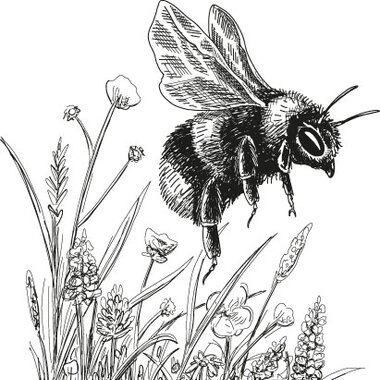
The Alpine bumble bee – buzzing pollinator
As its name suggests, the Alpine bumble bee lives up in the high mountains. Even way up in the summit regions of the three-thousand metre mountains. This makes it one of the most significant flower pollinators in the mountains! In one day, these bumble bees, with their extremely long proboscises, visit around 1000 flowers. In so doing, these resourceful insects employ a trick – if the calyx does not open – which can easily happen in spring in the high mountains – the bumble bee quickly nibbles a hole in the base of the petals to get to the nectar and pollen. The Bombus alpinus – to give it its scientific name – is out and about pollinating early on in the spring, thanks to its special ‘heating system’, whereas the little industrious worker bees are still hibernating.
Interesting facts about the Bombus alpinus
Habitat
This special bumble bee species is found in the Alps at an altitude of between 1600 and 3100 metres. One of the places the Alpine bumble bee builds its underground nests is in abandoned mice nests, where 100 to 150 insects can live in one colony.
Height & weight
The Alpine bumblebee is recognisable from its sheer size. With a body length of 22 to 26 mm and a wingspan of between 32 to 36 mm, the queen is clearly the boss. Worker bees and drones are smaller and only reach up to 17 mm in length, with a wingspan of up to 26 mm. The fuzzy hair on the bumble bee’s body has a black base colour, with an orange-red abdomen.
Diet
In the altitude locations where the bumble bee lives, they can’t afford to be choosy about the flowers they visit. However, Alpine bartsia, Alpine thistle, rusty-leaved Alpine rose, devil’s claw and primroses are among the most important food crops for them.
Lifespan
The Alpine bumble bee lives in colonies, but these only last for one year. In the autumn, all the worker bees die and only the queens overwinter. They then go on to set up a new colony in the next year.
Black-orange insect on the Red List
Few people know that, like all bees, bumble bees have two pairs of wings. However, these are not discernible when they are at rest – and when flying they are coupled together in such a way that they function like one pair. Yet bumble bees can actively uncouple both pairs of wings – to clean them for instance. Unfortunately, the Alpine bumble bee is on the Red List of endangered species. One more reason to protect their habitat, the flower-filled pastures in the high mountains! With this in mind, GROHAG – the operating company of the Grossglockner High Alpine Road – has set in place a wide range of measures to protect the delicate mountain pasture areas.
Where you’ll find the humming and buzzing …
The nature exhibition ‘Wunderwelt Glocknerwiese’ is a lovely nature exhibition at Gasthof Schöneck right on the Grossglockner High Alpine Road on the way to Kaiser-Franz-Josefs-Höhe. It reveals the beautiful flowers and variety of insects in the mountain pastures and provides interesting information about the plants and insects that grow and thrive in the nearby Pockhorner Wiesen.

